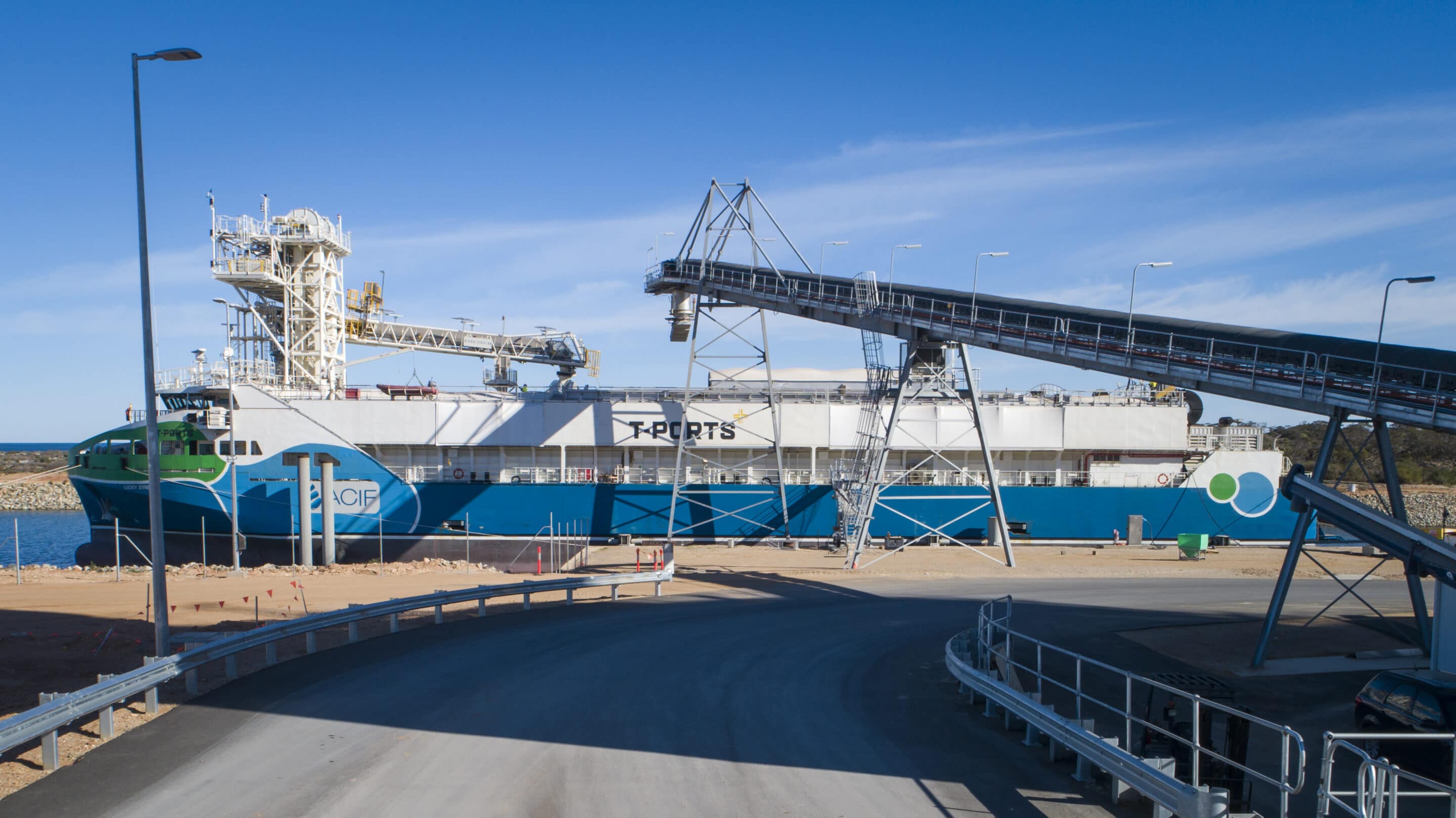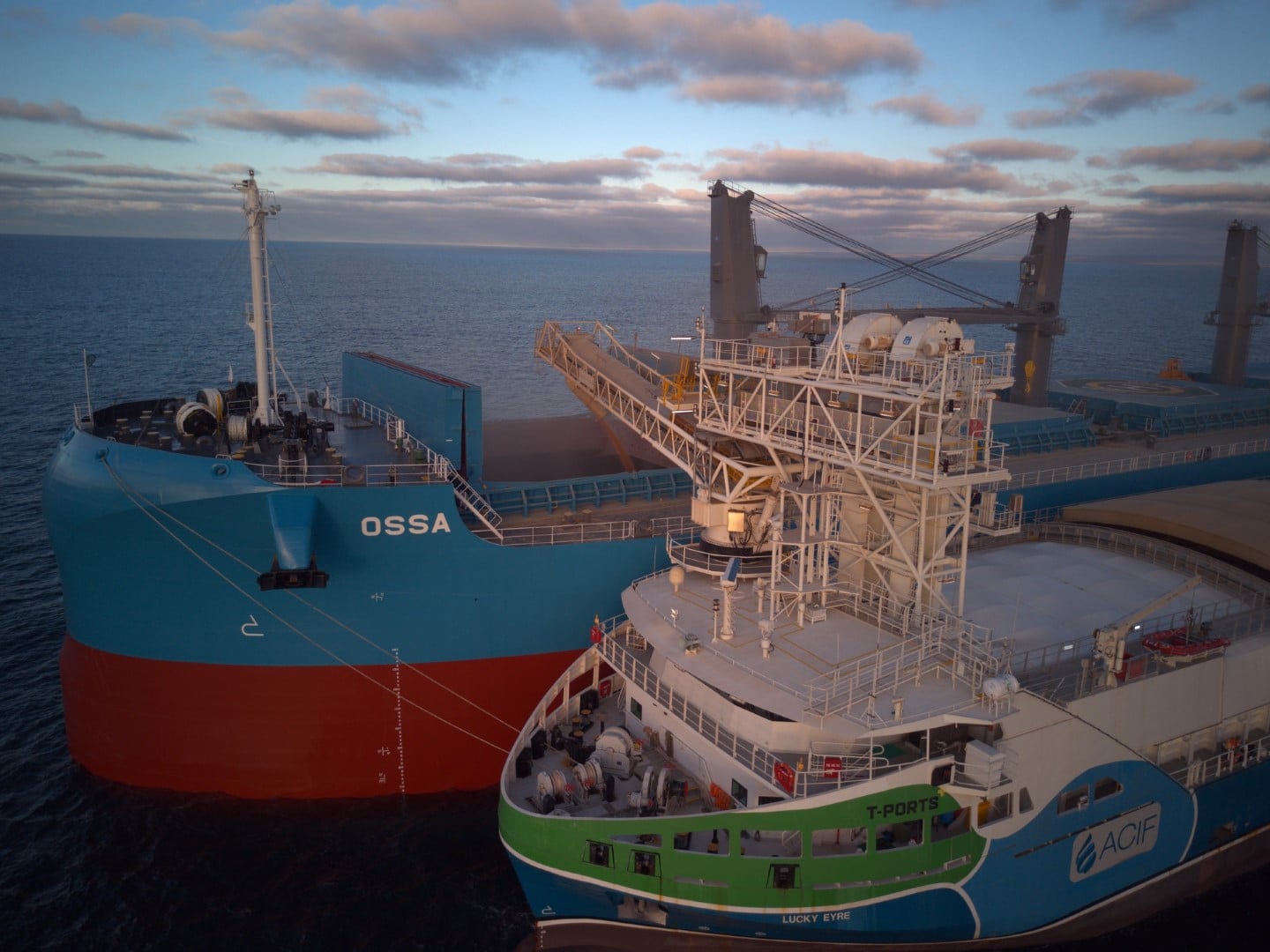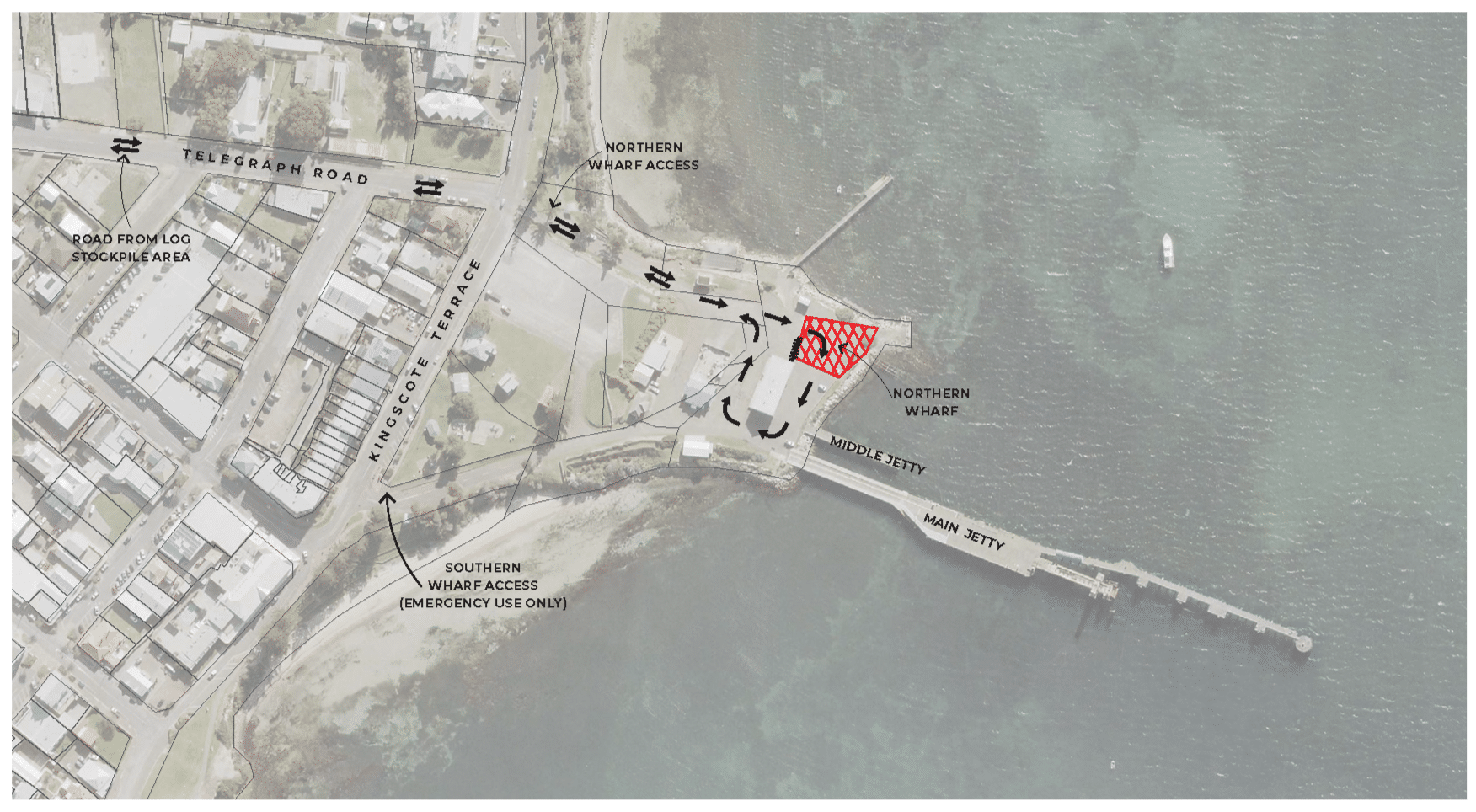Kingscote
Kangaroo Island has 4.5 million tonnes of fire-affected timber and biomass that needs removal so land can be rehabilitated for agricultural use.
T-Ports and HarvestCo are proposing to process this timber and export it via a temporary transhipment facility at Kingscote, with the goal of salvaging tonnes of useable product and delivering economic and social benefits to the island.
The reversion of land to open farmland can be sustainably facilitated by creating a pathway to process and remove some of the fire-affected timber.
T-Ports specialises in innovative solutions for the export of commodities, partnering with customers and investors to use a flexible model that positions port infrastructure close to the product’s origin.
Kingscote, Kangaroo Island
T-Ports has developed a proposal for timber export from Kangaroo Island using upgraded facilities at the existing Kingscote Wharf.
The proposal provides a low capital, rapidly implementable and temporary solution for the export of material volumes of timber, providing an easier path to market for timber from fire affected plantations which has retained value.
The proposal involves the development of a staging facility to the west of the Kingscote township and just-in-time trucking of woodchip/timber to the Kingscote Wharf for transhipment.
Upgrades proposed to the existing ramp and piles at the Kingscote Wharf will include a 60-65 metre extension to enable the transhipment vessel to dock at an extension of the old northern wharf. It will not affect public access to the main Kingscote jetty and foreshore area, even when operations are in progress. The proposal will result in the permanent upgrade of an existing dilapidated wharf structure, providing the potential for additional tourism and recreational uses, after the timber export campaign has been completed.
At the same time, the SA Government has embarked on a program to repair and maintain the existing structure for the benefit of the wharf users and the whole community.
Kangaroo Island faces a substantial challenge to remove the timber asset and, in doing so, remove a significant potential fire threat. The T-Ports facility is intended to be an interim solution to the log/timber problem, facilitating the harvesting and deforestation to enable the land to be rehabilitated for agricultural use. This will also reduce the potential for large-scale bushfires or controlled burning, both of which would significantly increase carbon emissions.
There is currently no alternative solution that is economically or environmentally viable, meaning there is a higher probability of the forests being burnt in-situ to facilitate conversion of the land.
Oceangoing vessels to be loaded annually
Days a month operations at Kingscote Wharf
The proposal
The T-Ports proposal involves a complete logistics chain from the receipt of the felled timber through to its removal from the island via transhipment. Under the T-Ports proposal, the majority of the timber will be processed into woodchips for shipment.
Stockyard
T-Ports is proposing to lease a portion of the Council’s land, located at the intersection of North Coast Road and Ten Trees Lagoon Road, Kingscote, for the bulk storage of wood and wood products prior to loading onto export vessels at the Kingscote Wharf. Additionally, T-Ports will process woodchips from logs on the site.
The facility will be capable of processing up to 400,000 tonnes of material per annum, however, the typical annual throughput is expected to be 250,000 tonnes. The site will store a maximum of 30,000 tonnes of material at any time.
The logistics chain proposed will involve logs being transported to the stockyard site. If chipping has occurred on site in the timber plantations, woodchips will also be transported.
Trucks will enter and exit the site via a new access point on Ten Trees Lagoon Road. Daily throughput will typically be just over 700 tonnes per day entering the stockyard site. This will equate to up to 23 vehicles (19 metre semi-trailers) entering the site to unload.
The stockyard site will operate from 7.00 am to 7.00 pm up to seven (7) days per week. Chipping operations will operate from 7.00 am to 7.00 pm from Monday to Saturday. Chipping operations will typically process 500 tonnes of material per day, with a maximum of 800 tonnes per day.
Kingscote Wharf Transhipping


At the wharf, material will be unloaded from trucks onto the Transhipment Vessel (TSV). The TSV will then transport the material to an oceangoing vessel (OGV) located at an identified transhipment point approximately 16 kilometres offshore. The material will then be transferred from the TSV to the OGV.
This cycle will repeat multiple times until the full load has been transferred to the OGV. The OGV will then leave the transhipment point, and logistic operations at the wharf and between the stockyard and wharf will cease until the next vessel is ready to be loaded.
It is proposed that up to 12 OGVs will be loaded each year, typically one export vessel per month. An OGV will take up to six to eight days to load, with the loading time dependant on the volume and prevailing weather conditions. The frequency of the OGVs will be limited during the high tourist months of December, January, and February.
A TSV movement will transport up to 2000 tonnes of material to the OGV. To load a TSV will involve between 38 trucks (if A-Doubles are used) and 41 trucks (if B-double trailers are used). The TSV cycles will occur twice per day (generally timed to depart the wharf at high tides). As the proposal is to use A-Double trucks, subject to the provision of relevant permits, an average of 80 trucks are expected to travel between the stockyard and the wharf each day.
Outside of the six to eight days per month when loading is occurring, activity at the wharf associated with the project will be minimal. A small amount of mobilisation and demobilisation will be required at the wharf before and after each OGV, including the erection of the acoustic screen and temporary fencing together with placement of drive over hoppers and loading conveyors.
An application by Maritime Constructions to the State Commission Assessment Panel for improvements to the existing wharf infrastructure at Kingscote has recently been granted Planning Approval.
Environmental investigations
T-Ports has engaged with ecological, acoustic and air quality consultants for this proposed development. The consultant team have undertaken comprehensive investigations into the potential impacts of its proposal. These have produced findings showing that the operations should not lead to adverse environmental impacts.
Air quality
SLR Consulting has undertaken an air quality investigation stating the proposed wharf operations may result in a small increase in particulate matter (PM10 and PM2.5), however, compliance with relevant guidelines should be achieved.
The report found that the most significant source of dust emissions will be from trucks accessing the stockyard site via Ten Trees Lagoon Road. SLR has recommended that higher capacity vehicles (such as A-Doubles) are used for movements between the stockyard and the wharf to minimise the number of movements.
SLR has concluded that relevant guidelines can be achieved at the nearest sensitive receptor for all but one day of the year for A-Doubles and B-Doubles and all but two days of the year for semi-trailers. This level of compliance is consistent with T-Ports’ existing sites on the Eyre Peninsula.
The technical report concludes that operational management techniques such as watering of hardstand areas and road and slowing or ceasing operations on site where unfavourable weather conditions are present should be capable of always achieving compliance with relevant guidelines.
It is considered that air quality impacts of the proposed operations, both at the stockyard site and wharf, are appropriate and unlikely to cause unreasonable environmental or amenity impacts.
Noise
Sonus has undertaken an acoustic assessment of the proposed development. The Sonus report has concluded that with practical acoustic treatments, both the stockyard and the wharf site can meet goal noise levels outlined in the policy at the nearest sensitive receivers.
At the stockyard site, acoustic barriers will be required along the northern and eastern boundaries of the operations area. Based on Sonus experience from other timber handling sites, these barriers can be constructed using the logs themselves, or alternatively with containers, earthen mounds or a combination.
At the wharf site, a barrier will be required to extend north from the shed nearest the wharf while operations are occurring. Such a barrier could be formed from containers and could be erected at the commencement of a vessel being loaded and removed at the completion of loading.
In summary, it is considered that acoustic impacts of the proposed operations, both at the stockyard site and wharf, are appropriate and unlikely to cause unreasonable environmental or amenity impacts.
Traffic
There has been a comprehensive review of the traffic movements associated with the proposal including the receival of material at the stockyard site and the dispatch of material from the stockyard site to the wharf. The Cirqa report has identified the extent of potential upgrades required and considered the capacity of the road network to accept the level of movement proposed.
Total traffic volumes forecast on local roads (North Coast Road and Ten Trees Lagoon Road) are well within the typical capacity of such roads (less than 1,500 vehicles per day). Similarly, total volumes forecast on Playford Highway, Kohinoor Road and Telegraph Road are also well within typical capacities for secondary arterial roads (less than 6,000 vehicles per day). Accordingly, the proposal will not impact upon the hierarchy or function of these roads.
Turning treatments are not required for the majority of the logistic route. A turning treatment could be required at the intersection of Playford Highway and Ten Trees Lagoon Road. Some minor geometric adjustments to other intersections may be required.
T-Ports will seek to negotiate an arrangement with Council and DIT in respect of any upgrade works required on public roads.
Truck movements
T-Ports’ preference is for timber product to be transported from the stockyard to the wharf via commercial vehicles up to 36.5 m in length (A-Doubles). This would reduce the daily number of vehicle movements over a number of road sections between the stockyard and the wharf. However, as the subject route is only partially gazetted for B-Doubles up to 23.0 m in length, a permit (or gazettal) would need to be sought from DIT and Council prior to either A-Double or regular 26.0 m B-Double vehicle movements occurring.
Logs brought to stockyard throughout the month
Chipping occurs during the course of the month
Transhipment vessel (TSV) and oceangoing vessel (OGV) arrive
Timber transported from stockyard to wharf
Timber loaded onto TSV as delivered
TSV (capacity 2,000 tonnes) transits to OGV
Logs transferred from TSV to OGV
Cycle repeats approximately twice per day
Loading of OGV with 25,000 – 30,000 tonnes of logs takes approx 6-8 days
Logs brought to stockyard throughout the month
Chipping occurs during the course of the month
Transhipment vessel (TSV) and oceangoing vessel (OGV) arrive
Timber transported from stockyard to wharf
Timber loaded onto TSV as delivered
Loading of OGV with 25,000 – 30,000 tonnes of logs takes approx 6-8 days
Cycle repeats approximately twice per day
Logs transferred from TSV to OGV
TSV (capacity 2,000 tonnes) transits to OGV


